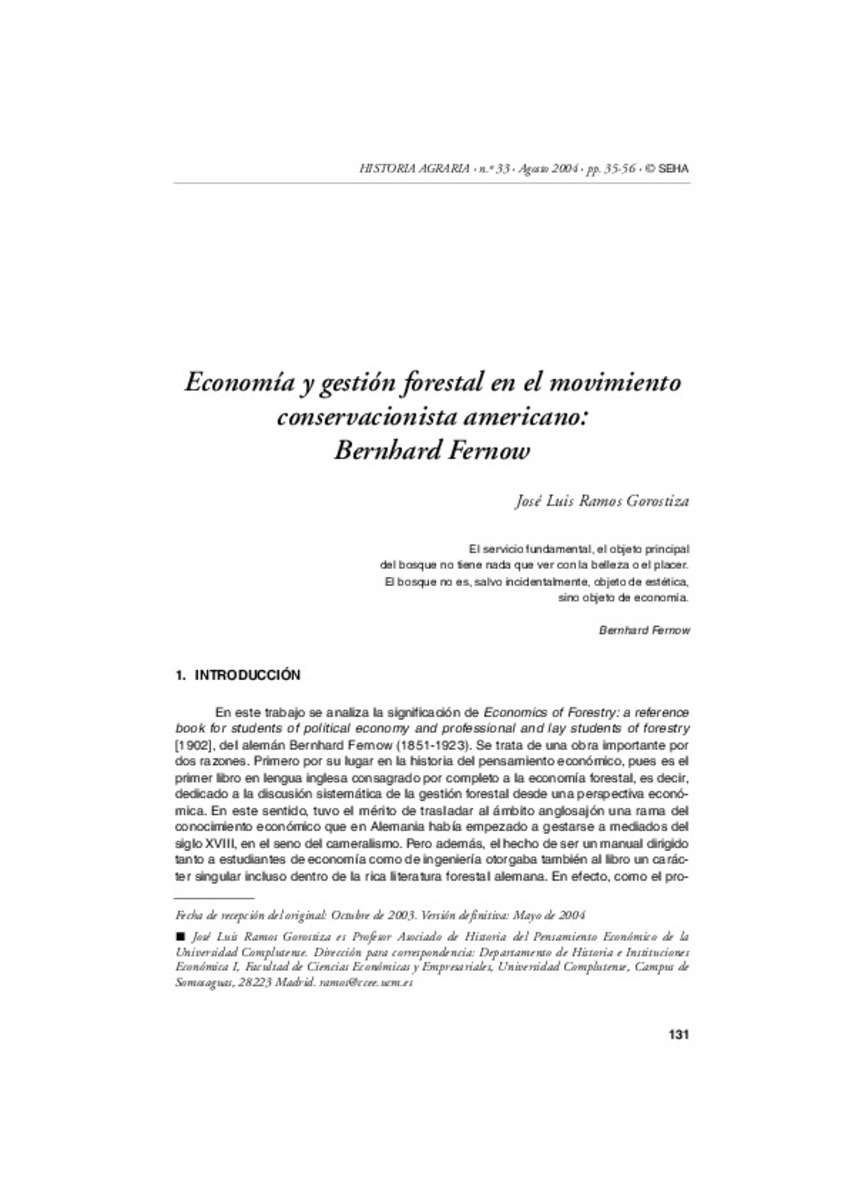Mostrar el registro sencillo del ítem
Economía y gestión forestal en el movimiento conservacionista americano: Bernhard Fernow
| dc.contributor.author | Ramos Gorostiza, José Luis | |
| dc.date.accessioned | 2016-05-17T08:29:14Z | |
| dc.date.available | 2016-05-17T08:29:14Z | |
| dc.date.issued | 2004-08 | |
| dc.identifier.issn | 1139-1472 | |
| dc.identifier.uri | http://hdl.handle.net/10234/159678 | |
| dc.description.abstract | Economics of Forestry [1902], de B. Fernow, tiene especial relevancia por dos motivos. Por un lado, es el primer libro en inglés enteramente dedicado al análisis de la gestión forestal desde una perspectiva económica, trasladando así al ámbito anglosajón una disciplina –la economía forestal– que había comenzado a gestarse a mediados del siglo XVIII en Alemania. Por otro lado, el libro posee una clara significación histórica, pues se publicó justo cuando el movimiento conservacionistaamericano comenzaba su etapa de mayor apogeo, encarnando a la perfección el ideal de gestión racional y científica del patrimonio naturalal servicio del progreso económico que guió el desarrollo del citado movimiento bajo el liderazgo de G. Pinchot –discípulo de Fernow. Sin mbargo, el estrecho utilitarismo asociado a esta concepción de la gestión forestal, que a finales del siglo XIX había sido una respuesta efectiva frente a los problemas relacionados con el clima, la escasez de madera y las talas indiscriminadas, acabó dando lugar a las críticas preservacionistas de J. Muir que, desde una visión más amplia del recurso, anticipaba ya planteamientos posteriores. | ca_CA |
| dc.description.abstract | The B. Fernow's Economics of Forestry [19021 is especially relevant for two reasons. On the one hand, it is the first book written in English entirely focused on a systematic discussion of forest management from an economic viewpoint. In fact, Fernow transferred forestry economics –a discipline that had begun to develop in Germany during the eighteenth century- to the English-speaking world. On the other hand, it is a book of great historical significance. It was published in 1902, just when the American Conservation Movement began its golden age, and when forestry itself epitomized the ideals of rational scientific management in the service of economic progress which guided the conservation policy leaded by G. Pinchot –a Fernow's disciple. However, the marked utilitarian bias associated with this conception of forest management -which at the end of the nineteenth century had been an effective response to the social concern about timber famine and the negative effects of fast deforestation- gave rise to the J. Muir's preservationist criticism, His wider view of the forest management anticipated later approaches to this matter. | ca_CA |
| dc.format.extent | 20 p. | ca_CA |
| dc.format.mimetype | application/pdf | ca_CA |
| dc.language.iso | spa | ca_CA |
| dc.publisher | Sociedad Española de Historia Agraria (SEHA) | ca_CA |
| dc.relation.isPartOf | Historia agraria: Revista de agricultura e historia rural, nº 33, p. 35-56 | ca_CA |
| dc.rights | © SEHA | ca_CA |
| dc.rights.uri | http://rightsstatements.org/vocab/InC/1.0/ | * |
| dc.subject | economics of forestry | ca_CA |
| dc.subject | Fernow | ca_CA |
| dc.subject | conservation movement | ca_CA |
| dc.subject | scientific management | ca_CA |
| dc.subject | Pinchot | ca_CA |
| dc.subject | economía forestal | ca_CA |
| dc.subject | conservación de bosques | ca_CA |
| dc.subject | gestión científica | ca_CA |
| dc.title | Economía y gestión forestal en el movimiento conservacionista americano: Bernhard Fernow | ca_CA |
| dc.type | info:eu-repo/semantics/article | ca_CA |
| dc.rights.accessRights | info:eu-repo/semantics/openAccess | ca_CA |
| dc.relation.publisherVersion | http://www.historiaagraria.com/info_articulo.php?id=361 | ca_CA |







